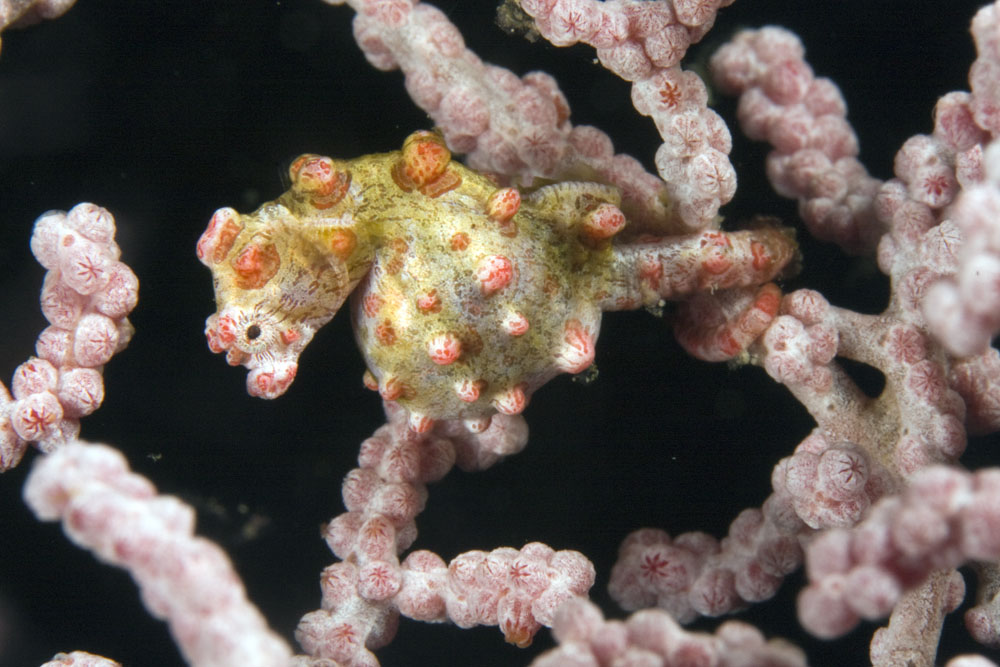Habitat
Where in th e world?
e world?
Between all 32 different species, seahorses can be found in many different ocean depths and in both tropical and temperate habitats in the Indo-Pacific and Atlantic Oceans (Lourie and Randall 2003). H. bargibanti in particular has been found in tropical oceanic regions of the Pacific, including areas of Indonesia, Japan, the Philippines, New Caledonia, Australia, and Papua New Guinea. They can be found 16-40 meters (45-130 feet) below ocean water (Lourie and Foster 2004). As it is a more recently discovered species and because of its tiny stature and camouflaging abilities, it is thought to exist in other locations that have not yet been discovered.
Habitat
Pygmy seahorses can be found inhabiting gorgonians, soft corals, and
hydrozoans. H. bargibanti in particular is found mainly on
one type of coral - they inhabit the corals of Muricella, of which
it can camouflage well in (Lourie and Foster 2004). Two specific
species they inhabit are Muricella plectana and
Muricella parplectana. They tend to remain on one gorgonian for
anywhere from 3 to 40 weeks (Baine, Barrows, Ganiga, and
Martin-Smith 2008). On M. paraplectana, H. bargibanti
camouflage by having yellow color with orange tubercles, while on
M. plectana, they camouflage with grey/purple bodies and
red/pink tubercles. This camouflage is yet another reason, along
with the recent discovery and small size of the species, that they
can be hard to find. In fact, this species of seahorse was
“accidently” discovered, since the scientist was performing lab work
on Muricella and stumbled upon this tiny seahorse. H.
bargibanti is often found in pairs, with up to 28 pairs on each
Muricella (Encyclopedia of Life).
H. bargibanti in particular is found mainly on
one type of coral - they inhabit the corals of Muricella, of which
it can camouflage well in (Lourie and Foster 2004). Two specific
species they inhabit are Muricella plectana and
Muricella parplectana. They tend to remain on one gorgonian for
anywhere from 3 to 40 weeks (Baine, Barrows, Ganiga, and
Martin-Smith 2008). On M. paraplectana, H. bargibanti
camouflage by having yellow color with orange tubercles, while on
M. plectana, they camouflage with grey/purple bodies and
red/pink tubercles. This camouflage is yet another reason, along
with the recent discovery and small size of the species, that they
can be hard to find. In fact, this species of seahorse was
“accidently” discovered, since the scientist was performing lab work
on Muricella and stumbled upon this tiny seahorse. H.
bargibanti is often found in pairs, with up to 28 pairs on each
Muricella (Encyclopedia of Life).
More information on this relationship with the coral Muricella
be found in
here.
Neighbors in the reef
Other organisms that are found in this same habitat include other species of seahorses as well. In fact, the same sea
fan, Muricella, also has other species of seahorses that inhabit it
(Lourie and Foster 2004).
Other species that are found in the area
include the sea sponge
Cryptotethya crypta, the
Common Starfish,
Red Algae,
Star Fruit, the
Yellow Tang, the
Mandarine Fish, the
Crown-of-Thorns
Starfish, the
Manta Ray, and the
Atlantic Spotted Dolphin. (These sites were all created by fellow UW-L students. To see a
complete list of sites by students, please visit
this list.)
Click here to learn about H. bargibanti's form and function!
To go back to the home page, click here.